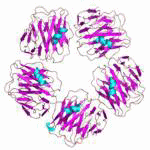Molecular Biology
|
1 october 2022 14:34:16 |
| Molecules, Vol. 27, Pages 6497: Polysorbates versus Hydroxypropyl Beta-Cyclodextrin (HPβCD): Comparative Study on Excipient Stability and Stabilization Benefits on Monoclonal Antibodies (Molecules) |
|
Tweet Polysorbates (PS 20 and PS 80) are the most widely used surfactants in biopharmaceutical formulations to protect proteins from denaturation, aggregation, and surface adsorption. To date, around 70% of marketed therapeutic antibodies contain either PS 20 or PS 80 in their formulations. However, polysorbates are chemically diverse mixtures, which are prone to degradation by oxidation and hydrolysis to produce peroxides and fatty acids, which, in turn, induce protein oxidation, aggregation, and insoluble particle formation. These will negatively impact protein quality and stability. Thus, polysorbate degradation has emerged as one of the major challenges in the development and commercialization of therapeutic protein products. KLEPTOSE® HPβCD (hydroxypropyl beta-cyclodextrin), a new multifunctional excipient, has been shown to provide protein stabilization functions in biopharmaceutical downstream processes and in their final formulations. This study aims to evaluate HPβCD, a new molecule of its class, against polysorbates as a stabilizer in biologics formulations. In this study, the chemical stability of KLEPTOSE® HPβCDs is compared with polysorbates (20 and 80) under various stress conditions. When subjected to heat stress, HPβCDs show little change in product recovery (90.7–100.7% recovery for different HPβCDs), while polysorbates 20 and 80 show significant degradation, with only 11.5% and 7.3% undegraded product remaining, respectively. When subjected to other chemical stressors, namely, autoclave, light, and oxidative stresses, HPβCD remains almost stable, while polysorbates show more severe degradation, with 95.5% to 98.8% remaining for polysorbate 20 and 85.5% to 97.4% remaining for polysorbate 80. Further, profiling characterization and degradation analysis reveal that chemical structures of HPβCDs remain intact, while polysorbates undergo significant hydrolytic degradation and oxidation. Lastly, the physicochemical stability of monoclonal antibodies in formulations is investigated. When subjected to light stress, adalimumab, as a model mAb, formulated in the presence of HPβCD, shows a significant decrease in protein aggregation, and superior monomer and total protein recovery compared to PS 80-containing formulations. HPβCD also reduces both agitation and thermal stress-induced protein aggregation and prevents subvisible particle formation compared to PS 80. |
| 101 viewsCategory: Biochemistry, Chemistry, Molecular Biology |
 Molecules, Vol. 27, Pages 6502: Clay-Catalyzed Ozonation of Hydrotalcite-Extracted Lactic Acid Potential Application for Preventing Milk Fermentation Inhibition (Molecules) Molecules, Vol. 27, Pages 6502: Clay-Catalyzed Ozonation of Hydrotalcite-Extracted Lactic Acid Potential Application for Preventing Milk Fermentation Inhibition (Molecules)Molecules, Vol. 27, Pages 6503: G-Protein Coupled Receptors in Human Sperm: An In Silico Approach to Identify Potential Modulatory Targets (Molecules) 
|
| blog comments powered by Disqus |
MyJournals.org
The latest issues of all your favorite science journals on one page
The latest issues of all your favorite science journals on one page



